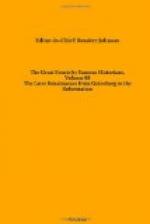The sculptor, not knowing which way to turn, besought the Pope to allow him to complete the work he was pledged to. He formed the wildest projects in order to escape the amicable compulsion of Paul, among others that of retiring to Carrara, where he had passed some tranquil years among the mountains of marble. The Pontiff, to put an end to all these discussions, issued a brief, dated September 18, 1537, wherein he declared Michelangelo, his heirs and successors, released from all obligations resulting from the different contracts entered into on the subject of the monument. This fashion of terminating things could not satisfy the Duke of Urbino nor relieve Michelangelo. The negotiations were again resumed, and it ended in their agreement that the monument should be raised in the form in which we now see it in the Church of San Pietro in Vinculo, and should be composed of the statue of “Moses” executed entirely by the hand of Michelangelo; of two figures personifying “Active Life” and “Contemplative Life,” which were already much advanced, but were to be finished by Rafaello de Monte Lupo; of two other statues by this master—a “Madonna,” after a model by Michelangelo, and the figure of “Julius,” by Maso del Bosco.
Such is the very abridged history of this monument, which was not entirely completed till 1550, after having caused for nearly half a century real torment to Buonarroti. The Duke of Urbino was not satisfied, neither was Michelangelo. The figures, originally intended to form part of a colossal whole under the great roof of St. Peter’s, appear too large for the place they now occupy. The importance of the statue of “Moses” misleads the mind, suggesting the idea that the monument itself is raised to the memory of the Hebrew legislator, rather than to that of the warrior-pope. At all events, in this statue is centred the principal, we may say the unique, interest of the tomb. This prodigious work must be in the memory of all. Amid the masterpieces of ancient and modern sculpture the “Moses” remains ever unparalleled, a type, not irreproachable, but the most striking, of a new art. I do not speak of the consummate science which Michelangelo displays in the modelling of this statue; the Greeks were learned in another fashion, but were so equally with him. Whence comes it, nevertheless, that in spite of bizarreries needless to defend or to deny, and although this austere figure is far from attaining or pretending to the serene and tranquil beauty which the ancients regarded as the supreme term of art, whence is it that it produces upon the most prejudiced mind an irresistible impression? It is that it is more than human, that it lifts the soul into a world of feelings and ideas of which the ancients knew less than we do. Their voluptuous art, in deifying the human form, held down thought to earth. The “Moses” of Michelangelo beheld God, heard that voice of thunder, and bears the terrible impress of what he saw and heard on Mount




